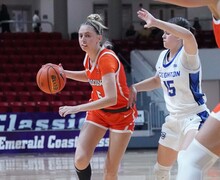IRS form reveals top SU officials’ salaries, pay for all employees increases by 3 percent
Head football coach Doug Marrone’s salary is disclosed. Chancellor Nancy Cantor’s salary and compensation is revealed a year after she ranked among the most highly compensated college presidents in the country. All Syracuse University employees received a 3 percent pay increase during the recession, which is the same time when the university’s expenses outweighed its revenues.
All are highlights in SU’s most recent Internal Revenue Service Form 990 report. In terms of SU officials’ salaries, the most recent 990 covers calendar year 2009, from Jan. 1, 2009, to Dec. 31, 2009. But the university’s revenues and expenses cover the 2009-10 fiscal year, which runs from July 1, 2009, to June 30, 2010.
The football coach
In 2009, his first year as head coach of the SU football team, Marrone made a base salary of $1,017,646 en route to leading the Orange to a 4-8 record.
Though Marrone led the team to a better record than the 3-9 record his predecessor Greg Robinson put up in 2008, Marrone made about $78,000 less than Robinson in base compensation. Robinson — who coached the Orange from 2005 to 2008 and compiled a 10-37 record — was paid $2,214,505 in 2008, which included a $1,083,309 buyout for not coaching the final season of his five-year contract and $1,095,987 in base salary for coaching his fourth season.
‘Each coach has a contract they negotiate with the athletics director and the university, and there’s a whole bunch of variables in every contract that can affect salary, incentives, timing and so forth,’ said Kevin Quinn, SU’s senior vice president for public affairs.
Quinn declined to disclose the terms of Marrone’s contract or whether the head coach received a raise or bonus following the team’s 8-5 record and New Era Pinstripe Bowl victory last season.
At SU, all athletic department salaries, including coaches and officials, such as the athletic director, are paid for out of athletics revenues. Income from athletics includes ticket sales, gifts and sponsorships, among others.
But a portion of athletic officials’ salaries are paid through International Sports Properties Inc., a marketing and multimedia company that holds the rights to radio and TV for SU sports, Quinn said.
For example, Marrone’s base salary of $1,017,646 includes $305,672 paid by SU, $700,000 from International Sports Properties and a net income of $11,974 realized from conducting a summer football camp.
The chancellor
In 2008, SU Chancellor Cantor was among the 30 private college presidents who earned more than $1 million in total compensation. Cantor was listed as the 14th-highest paid president with a total compensation of $1,386,464, which included a one-time bonus of $500,000.
But Cantor gave the bonus back to the university as part of a $1 million donation with her husband, Steven Brechin, an SU sociology professor. The gift was announced Oct. 31, 2007, as a donation to SU’s capital campaign, The Campaign for Syracuse University, which has a goal of raising $1 billion.
The $500,000 bonus was given to Cantor for the completion of her first contract, which ran from 2004 to June 2008. SU’s Board of Trustees awarded Cantor a new six-year contract through 2014 in June 2008.
In 2009, Cantor’s total compensation was down to $895,025, but her base salary was more than $17,000 higher than her base compensation of $598,758 in 2008.
In March 2009, Cantor announced she was taking a 10 percent pay cut for the 2009-10 fiscal year in light of the recession and its effect on the university. Cantor’s base salary in 2009 was $615,882, according to the 990 report.
‘That’s her base salary for the year and that does reflect half the year’s 10 percent voluntary pay reduction,’ Quinn said.
Only half of the 10 percent pay cut is reflected in the most recent 990 because the report is based on the 2009 calendar year, while the pay reduction is based on the 2009-10 fiscal year, Quinn said. Cantor’s pay cut started July 1, 2009, and ended June 30, 2010, meaning half of the reduction will be included in next year’s report, he said.
In deferred compensation, Cantor had $151,336, which is ‘money that she hasn’t received and hasn’t been paid to her, but it’s pursuant to provisions of her contract,’ Quinn said. Cantor will receive the deferred funds when she completes her contract in 2014.
Cantor also had $123,897 in nontaxable benefits in 2009. The benefits primarily include university contributions to a retirement plan and university housing that the chancellor is required to live in, the report’s footnotes stated.
It includes the annual value of her living in the chancellor’s residence and the value of her having the use of the chancellor’s apartment at the Joseph I. Lubin House in New York City. The Lubin House is where SU holds meetings, classes and interviews, among other events. Cantor uses Lubin House for business purposes.
The chancellor also had $3,910 in other compensation, which is considered a catch-all category. Quinn said it includes miscellaneous memberships, such as belonging to a business club.
The employees
Although the most recent 990 reflects the effects of the recession, it also shows that all university employees received a pay increase.
In the 2008-09 fiscal year, which runs from July 1, 2008, to June 30, 2009, there was a university-wide 3 percent pay increase, Quinn said. Because the most recent 990 is based on the 2009 calendar year in terms of university officials’ salaries, only half of the pay increase is included in this report, he said. This means half of the 2008-09 fiscal year — from Jan. 1, 2009, to June 30, 2009 — is included in the most recent 990 report.
‘Half of this calendar year of 2009 had a raise in it, so this is half of a 3 percent raise because for the second part of calendar year 2009 there was no raise,’ Quinn said.
But the other half of the most recent 990 includes half of the 2009-10 fiscal year, when university employees who made $50,000 and under were given a 2 percent raise. SU officials who earned $50,000 or more had their salaries frozen for the 2009-10 fiscal year, the same time period when Cantor took the voluntary 10 percent pay cut, Quinn said.
Increases in base salaries among SU officials on the report can be explained by the 3 percent pay increase, Quinn said. But three top SU officials had significant differences in pay from the amounts in the previous 990 report that covered the 2008 calendar year.
In 2008, Christopher Sedore earned $126,465, but his salary went up to $180,134 in 2009 as a result of a promotion to vice president for information technology and chief information officer.
Youlonda Copeland-Morgan, associate vice president for enrollment management and director of scholarships and student aid, earned $112,997 in 2008 compared to $178,334 in 2009. George Langford, dean of the College of Arts and Sciences, made $179,400 in 2008 compared to $358,773 in 2009.
After being hired, deans and other top officials typically begin at the university July 1 or Aug. 1 of a given year, Quinn said. Both Langford and Copeland-Morgan began midyear at SU in 2008, meaning only half of their salary was reported on the 990 that covered the 2008 calendar year, he said. The most recent 990 that covers 2009 reflects both Langford’s and Copeland-Morgan’s full compensation, Quinn said.
‘What was reported on last year’s 990 for people like George and Youlonda was basically half a year’s salary or less,’ he said. ‘That’s not a raise.’
The university
Unlike SU officials’ salaries, the university’s revenues and expenses on the most recent 990 cover the 2009-10 fiscal year, which runs from July 1, 2009, to June 30, 2010.
During the 2009-10 fiscal year, SU had $978,979,966 in total revenue, which included more than $63 million in contributions and grants; nearly $875 million in program service revenue; about $33.5 million in investment income; and about $7.5 million in other revenue.
SU also had $979,923,676 in total expenses, which included about $236 million in grants and similar amounts paid; more than $456 million in salaries, other compensation and employee benefits; and about $287 million in other expenses.
In the 2008-09 fiscal year — a year along with the 2009-10 fiscal year when the university felt the effects of the recession — SU had a total revenue of $828,608,567 compared to about $934 million in total expenses. In 2008-09, SU had an unrealized loss of nearly $98 million in investment income compared to $33.5 million to the good in 2009-10. The $98 million is unrealized because the university didn’t make a transaction to generate a gain or a loss, but rather held on to it and saw a change based on the changes within the market, said Lou Marcoccia, SU’s chief financial officer and executive vice president.
‘You can see what happened with the investment income, in one year it’s negative and in the next year it’s positive,’ Marcoccia said. ‘That all has to do with what’s happening in the market, so that has a real big impact on the change in the total revenues here, that’s a change that’s worth about $130 million.’
The university’s net assets, after taking into account total liabilities, were nearly $1.46 billion in 2009-10 while net assets totaled about $1.38 billion in 2008-09.
Marcoccia said the university’s assets increased substantially — in large part because of the market — for the 2010-11 fiscal year, which ended June 30.
‘The net assets are really going to change primarily based on what’s going to happen to the market value and its investments,’ Marcoccia said. ‘That’s really going to be the key change because you’re assuming that your revenues and your expenses are just going to balance.’
Published on September 4, 2011 at 12:00 pm
Contact Jon: jdharr04@syr.edu





